#Seismic Isolation
Text
0 notes
Text
Deep Freeze
The thing about Danny was that it was always his most easily overlooked powers that were the most dangerous. Who remembers his telekinesis when he never uses it? Or how he chews through metal with teeth that never can decide how sharp they are? But the worst is the ice.
See, Danny can make ice. Most of the time, this is just a neat party trick or a way to slip up fools who try to run, but the thing about his ice is that it absorbs energy at an infinite rate. Nothing can break it, and if you try, you’ll find it just gets colder. Left to its own devices, Danny’s ice will grow exponentially colder over time, dropping the surrounding temperature as it goes. The upside is that this could well be the solution to global warming everyone is looking for.
On the other hand, this could also be the thing that finally kills off the human race for good, as ice covers everything it touches, and the temperature drops ever closer to true zero. Even a single patch is a risk of global proportion. The only thing or person who can remove this ice is Danny. This has not stopped him from using it as a coolant in machines.
It's not just the ice, either. See, there is a funny thing about the cold. The further the temperature drops, the more reality starts to act up. Thanks to good old Icotrophic propagation, the colder air gets, the further sound travels. Danny’s voice, therefore, can be heard from impossible distances when he chooses, something his ghostly wail takes full advantage of. Even touching him when he's using his powers can cause instant onset hypothermia, human skin blackening within seconds as the blood supply cuts off. Your muscles cease, and your lungs stop inflating.
The temperature keeps dropping. As he reached absolute zero, the rules of quantum mechanics started to change; superfluids formed, making it seem as if gravity itself froze over, and local atoms began to act as a singular. His body becomes surreal. Forget about the manipulation of gravity. Forget about his ghostly form; just the cryokinesis alone scares the shit out of people.
#eldrich danny#danny phantom#I love my little danger Elsa#he is wonderful and perfectly capable of ending the world#btw ectoplasm is a superfluid#My next target will be going over gravity manipulation but that one isn't technically cannon#if you ask me it's the isolation of this cryokinesis which is so impressive#this also means that his ghostly wail is a combination of a wide range of frequencies paired with extreme cold fronts of air#people who are hit shatter on impact#weather becomes erratic and dangerous worldwide butterfly style#it can even upset seismic activities
159 notes
·
View notes
Text
Genocide experts warn that India is about to genocide the Shompen people
Who are the Shompen?
The Shompen are an indigenous culture that lives in the Great Nicobar Island, which is nowadays owned by India. The Shompen and their ancestors are believed to have been living in this island for around 10,000 years. Like other tribes in the nearby islands, the Shompen are isolated from the rest of the world, as they chose to be left alone, with the exception of a few members who occasionally take part in exchanges with foreigners and go on quarantine before returning to their tribe. There are between 100 and 400 Shompen people, who are hunter-gatherers and nomadic agricultors and rely on their island's rainforest for survival.

Why is there risk of genocide?
India has announced a huge construction mega-project that will completely change the Great Nicobar Island to turn it into "the Hong Kong of India".
Nowadays, the island has 8,500 inhabitants, and over 95% of its surface is made up of national parks, protected forests and tribal reserve areas. Much of the island is covered by the Great Nicobar Biosphere Reserve, described by UNESCO as covering “unique and threatened tropical evergreen forest ecosystems. It is home to very rich ecosystems, including 650 species of angiosperms, ferns, gymnosperms, and bryophytes, among others. In terms of fauna, there are over 1800 species, some of which are endemic to this area. It has one of the best-preserved tropical rain forests in the world.”
The Indian project aims to destroy this natural environment to create an international shipping terminal with the capacity to handle 14.2 million TEUs (unit of cargo capacity), an international airport that will handle a peak hour traffic of 4,000 passengers and that will be used as a joint civilian-military airport under the control of the Indian Navy, a gas and solar power plant, a military base, an industrial park, and townships aimed at bringing in tourism, including commercial, industrial and residential zones as well as other tourism-related activities.
This project means the destruction of the island's pristine rainforests, as it involves cutting down over 852,000 trees and endangers the local fauna such as leatherback turtles, saltwater crocodiles, Nicobar crab-eating macaque and migratory birds. The erosion resulting from deforestation will be huge in this highly-seismic area. Experts also warn about the effects that this project will have on local flora and fauna as a result of pollution from the terminal project, coastal surface runoff, ballasts from ships, physical collisions with ships, coastal construction, oil spills, etc.
The indigenous people are not only affected because their environment and food source will be destroyed. On top of this, the demographic change will be a catastrophe for them. After the creation of this project, the Great Nicobar Island -which now has 8,500 inhabitants- will receive a population of 650,000 settlers. Remember that the Shompen and Nicobarese people who live on this island are isolated, which means they do not have an immune system that can resist outsider illnesses. Academics believe they could die of disease if they come in contact with outsiders (think of the arrival of Europeans to the Americas after Christopher Columbus and the way that common European illnesses were lethal for indigenous Americans with no immunization against them).
And on top of all of this, the project might destroy the environment and the indigenous people just to turn out to be useless and sooner or later be abandoned. The naturalist Uday Mondal explains that “after all the destruction, the financial viability of the project remains questionable as all the construction material will have to be shipped to this remote island and it will have to compete with already well-established ports.” However, this project is important to India because they want to use the island as a military and commercial post to stop China's expansion in the region, since the Nicobar islands are located on one of the world's busiest sea routes.
Last year, 70 former government officials and ambassadors wrote to the Indian president saying the project would “virtually destroy the unique ecology of this island and the habitat of vulnerable tribal groups”. India's response has been to say that the indigenous tribes will be relocated "if needed", but that doesn't solve the problem. As a spokesperson for human rights group Survival International said: “The Shompen are nomadic and have clearly defined territories. Four of their semi-permanent settlements are set to be directly devastated by the project, along with their southern hunting and foraging territories. The Shompen will undoubtedly try to move away from the area destroyed, but there will be little space for them to go. To avoid a genocide, this deadly mega-project must be scrapped.”
On 7 February 2024, 39 scholars from 13 countries published an open letter to the Indian president warning that “If the project goes ahead, even in a limited form, we believe it will be a death sentence for the Shompen, tantamount to the international crime of genocide.”
How to help
The NGO Survival International has launched this campaign:
From this site, you just need to add your name and email and you will send an email to India's Tribal Affairs Minister and to the companies currently vying to build the first stage of the project.
Share it with your friends and acquittances and on social media.
Sources:
India’s plan for untouched Nicobar isles will be ‘death sentence’ for isolated tribe, 7 Feb 2024. The Guardian.
‘It will destroy them’: Indian mega-development could cause ‘genocide’ and ‘ecocide’, says charity, 8 Feb 2024. Geographical.
Genocide experts call on India's government to scrap the Great Nicobar mega-project, Feb 2024. Survival International.
The container terminal that could sink the Great Nicobar Island, 20 July 2022. Mongabay.
[Maps] Environmental path cleared for Great Nicobar mega project, 10 Oct 2022. Mongabay.
#shompen#genocide#stop genocide#india#indigenous#indigenous peoples#indigenous rights#human rights#anthropology#stateless nations#end occupation#andaman and nicobar islands#nicobar islands#great nicobar#💬#asia#geopolitics#ecocide#sustainability
17K notes
·
View notes
Text
Little P.Eng.'s Comprehensive Seismic Structural Services Aligned with ASCE 7-22 and NBCC Standards
In an era where architectural ambition pushes the limits of engineering, safeguarding structural integrity against natural calamities, particularly seismic activities, becomes paramount. This detailed exposé delves into the sophisticated seismic structural engineering services provided by Little P.Eng., a firm renowned for its compliance with the latest American Society of Civil Engineers (ASCE) 7-22 standards and the Canadian National Building Code (NBCC). Their work spans across Canada and the United States, encompassing a diverse range of buildings and non-structural elements, reflecting the pinnacle of safety, reliability, and innovation in modern construction.
1. Introduction
The unpredictable nature of seismic activities has long posed a significant challenge to the realms of construction and civil engineering. Within this volatile environment, Little P.Eng. has emerged as a beacon of reliability, offering cutting-edge seismic structural engineering services across Canada and the United States. Their adherence to the ASCE 7-22 and NBCC codes ensures not only the structural integrity of vast construction undertakings but also the safety and longevity of non-structural elements, affirming their position at the forefront of seismic resilience in contemporary infrastructure.
2. Understanding Seismic Structural Engineering
2.1. The Science of Earthquake Engineering
Before delving into Little P.Eng.'s specialized services, one must understand the core principles of seismic structural engineering. This discipline focuses on making buildings and non-structural components resistant to earthquake shocks through specialized planning, design, detailing, and, subsequently, construction. It encompasses geological science, material engineering, and structural analysis to develop structures capable of withstanding seismic disturbances.
2.2. Evolution of Seismic Codes: From ASCE 7-10 to ASCE 7-22
Seismic building codes are dynamic, evolving in response to the continuous advancements in engineering research and catastrophic lessons learned from each seismic event. The transition from ASCE 7-10 to ASCE 7-22 is a reflection of this evolution, marking significant strides in risk reduction and structural robustness, emphasizing not just human safety but also post-earthquake functionality and rapid recovery for communities.
3. Little P.Eng.’s Integration of ASCE 7-22 in Seismic Structural Engineering
3.1. Innovations in Seismic Design Philosophies
Little P.Eng. employs a forward-thinking approach to integrate the innovations outlined in ASCE 7-22. These include state-of-the-art seismic design philosophies involving base isolation, energy dissipation devices, and performance-based seismic design (PBSD), allowing for structures that are more flexible, absorb and dissipate seismic energy, and maintain structural integrity during earthquakes.
3.2. Site-Specific Hazard Analysis and Geotechnical Considerations
One of the critical aspects of ASCE 7-22 is the emphasis on site-specific hazard analyses. Little P.Eng.'s engineers led by Meena Rezkallah carry out comprehensive geotechnical evaluations, considering soil-structure interaction, liquefaction potential, and site-specific seismic hazard assessments. By understanding the geological variances across different regions in North America, they ensure that each design is intrinsically aligned with its environmental context.
4. Adherence to NBCC Standards: Expanding Safety Parameters Across Canada
4.1. Bridging Policies between Countries
While their services in the United States predominantly adhere to ASCE standards, Little P.Eng. seamlessly bridges engineering policies between the U.S. and Canada by aligning their practices with the NBCC. This code compliance not only underscores their versatility in handling cross-border projects but also reflects their commitment to upholding the highest safety and professional standards in every geographical locale.
4.2. Understanding NBCC’s Seismic Provisions
The NBCC has distinct seismic provisions, necessitating specialized knowledge and an adaptive engineering approach. Little P.Eng.'s expertise in Canadian seismic codes ensures that structural and non-structural components comply with regional regulations, catering to Canada's unique seismic challenges, especially in high-risk provinces.
5. Comprehensive Services for Buildings and Non-Structural Elements
5.1. Diverse Building Typologies
Little P.Eng.'s portfolio encompasses a variety of buildings, from residential high-rises and expansive commercial complexes to critical facilities like hospitals and emergency response centers. Each building type presents unique challenges, and the firm’s nuanced, context-oriented approach to seismic retrofitting and sustainable design practices sets industry standards.
5.2. Protecting Non-Structural Components
Beyond the buildings themselves, Little P.Eng. extends its engineering prowess to safeguard non-structural elements. These components, often overlooked, can pose significant hazards during seismic events. From architectural elements to mechanical and electrical systems, the firm implements exhaustive strategies to enhance the safety of these components, thereby protecting human life and minimizing economic loss.
6. Future Directions and Continuous Advancements
6.1. Embracing Technological Innovations
As the field of seismic structural engineering advances, Little P.Eng. remains committed to incorporating new technologies, including artificial intelligence and machine learning, for predictive analysis, design optimization, and risk management. Their continual investment in technology positions them as a leader in future-proofing structures against earthquakes.
6.2. Contribution to Global Seismic Safety Standards

Harnessing Advanced Engineering: Little P.Eng.'s Comprehensive Seismic Structural Services Aligned with ASCE 7-22 and CNBCC Standards in North America
7. Conclusion
Little P.Eng.’s comprehensive seismic structural engineering services, grounded in the latest ASCE and NBCC standards, represent a confluence of scientific mastery, innovative engineering, and a deep commitment to safeguarding human lives and investments. Their work across diverse building typologies and non-structural components in Canada and the United States cements their stance as a pivotal player in shaping resilient, sustainable, and safe urban landscapes. As seismic activity remains an unpredictable threat, the foresight and innovation of firms like Little P.Eng. are society's best bet for a safer tomorrow.
References
[1] American Society of Civil Engineers. (2022). Minimum Design Loads and Associated Criteria for Buildings and Other Structures (ASCE/SEI 7-22). ASCE.
[2] National Research Council Canada. (2020). National Building Code of Canada.
Tags:
Little P.Eng.
ASCE 7-22
design optimization
earthquake resilience
energy dissipation
building codes
seismic design
advanced materials
non-structural components
CNBCC
technological innovations
cross-border projects
geotechnical considerations
mechanical systems safety
base isolation
sustainable construction
electrical systems safety
Seismic structural engineering
critical infrastructure
artificial intelligence
urban resilience
construction techniques
seismic retrofitting
site-specific analysis
predictive analysis
professional standards
safety regulations
risk management
performance-based design
global seismic standards
Engineering Services
Structural Engineering Consultancy
Seismic Bracing Experts
Located in Calgary, Alberta; Vancouver, BC; Toronto, Ontario; Edmonton, Alberta; Houston Texas; Torrance, California; El Segundo, CA; Manhattan Beach, CA; Concord, CA; We offer our engineering consultancy services across Canada and United States. Meena Rezkallah.
#Little P.Eng.#ASCE 7-22#design optimization#earthquake resilience#energy dissipation#building codes#seismic design#advanced materials#non-structural components#CNBCC#technological innovations#cross-border projects#geotechnical considerations#mechanical systems safety#base isolation#sustainable construction#electrical systems safety#Seismic structural engineering#critical infrastructure#artificial intelligence#urban resilience#construction techniques#seismic retrofitting#site-specific analysis#predictive analysis#professional standards#safety regulations#risk management#performance-based design#global seismic standards
0 notes
Text
Earthquake-Resistant Building Design: A Guide to Safer Structures
In regions prone to seismic activity, earthquake-resistant building design is not a luxury but a necessity. The primary goal of such design is to ensure that structures can withstand the shaking and shifting of the earth without catastrophic failure. This is achieved through a deep understanding of geotechnical engineering principles, materials science, and the dynamics of seismic forces. By…
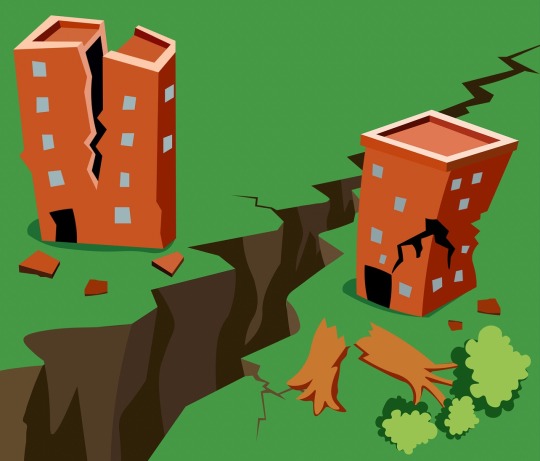
View On WordPress
#architecture#base isolation#building construction#building innovation#community resilience#construction technology#ductility in structures#earthquake preparedness#earthquake-resistant design#retrofitting#seismic codes#seismic safety#shock absorbers#smart materials#structural engineering
0 notes
Text
What is a seismic isolator and how does it work?
As an architect and engineer, I have seen firsthand the devastation that earthquakes can cause to buildings and communities. That's why I always emphasize the importance of seismic isolators in building design and construction. In this article, I will explain what seismic isolators are, how they work, and why they are crucial in earthquake-prone areas. One of the methods of مقاوم سازی ساختمان در برابر زلزله is the installation of seismic isolators, which we will discuss in this article.

Introduction to Seismic Isolators
Seismic Isolators are devices that are used to separate a building's superstructure from its substructure, such as the foundation or the ground. The purpose of this separation is to reduce the amount of seismic energy that is transferred to the building during an earthquake. Seismic isolators can be made of various materials, such as rubber, steel, or lead, and they come in different shapes and sizes depending on the building's specific needs.
What are Seismic Isolators and How Do They Work?
Seismic isolators work by allowing the building to move independently of the ground during an earthquake. When an earthquake occurs, the ground shakes, and the building moves with it. However, if the building is equipped with seismic isolators, the isolators act as a buffer between the building and the ground, absorbing some of the seismic energy and reducing the amount that is transferred to the building. This helps to minimize damage to the building and increase its chances of survival.
Seismic isolators can be passive or active. Passive isolators rely on the building's weight to function, while active isolators use sensors and control systems to adjust their stiffness and damping properties in real-time. Active isolators are more expensive than passive isolators, but they offer greater control and can provide better protection against earthquakes.
The Importance of Seismic Isolators in Earthquake-Prone Areas
Seismic isolators are crucial in earthquake-prone areas because they help to protect buildings and their occupants from the damaging effects of earthquakes. Without seismic isolators, buildings are more likely to suffer structural damage or collapse during an earthquake, putting people's lives at risk. In earthquake-prone areas, seismic isolators are often required by law or building codes to ensure the safety of the building and its occupants.
For example, in Japan, where earthquakes are common, seismic isolation technology has been used for over 30 years to protect buildings from earthquakes. As a result, Japan has one of the world's lowest rates of earthquake-related fatalities and injuries. This demonstrates the effectiveness of seismic isolators in reducing the impact of earthquakes on buildings and their occupants.
Benefits of Using Seismic Isolators in Building Construction
There are several benefits to using seismic isolators in building construction. Firstly, seismic isolators can help to reduce the cost of earthquake damage by minimizing the need for repairs and rebuilding. Secondly, seismic isolators can increase the lifespan of a building by reducing the amount of wear and tear caused by earthquakes. Finally, seismic isolators can improve the comfort and safety of the building's occupants by reducing the amount of shaking and vibration during an earthquake.
Different Types of Seismic Isolators
There are several types of seismic isolators available, each with its own advantages and disadvantages. The most common types of seismic isolators are:
Rubber Bearings: Rubber bearings are the most common type of seismic isolator and are made of layers of rubber and steel plates. They are cost-effective and provide good isolation performance.
Lead Rubber Bearings: Lead rubber bearings are similar to rubber bearings but have a layer of lead in the middle. They provide better isolation performance than rubber bearings but are more expensive.
Friction Pendulum Bearings: Friction pendulum bearings use a pendulum-like mechanism to isolate the building. They are effective in reducing horizontal forces but can be expensive and require regular maintenance.
Fluid Viscous Dampers: Fluid viscous dampers use a fluid to absorb seismic energy and reduce the building's movement during an earthquake. They are effective but can be expensive and require regular maintenance.
Case Studies Showcasing the Effectiveness of Seismic Isolators
There are many case studies that demonstrate the effectiveness of seismic isolators in protecting buildings during earthquakes. One such example is the Golden Gate Bridge in San Francisco, which was retrofitted with seismic isolators in the 1990s. During the Loma Prieta earthquake in 1989, the bridge suffered damage, but after the retrofit, it was able to withstand the 6.9 magnitude earthquake that struck the region in 2003 without suffering any significant damage.
Another example is the Taipei 101 skyscraper in Taiwan, which is one of the tallest buildings in the world. The building was equipped with a tuned mass damper and 36 seismic isolators to protect it from earthquakes. During the 921 earthquake in 1999, the building swayed but remained intact, demonstrating the effectiveness of seismic isolation technology.
Factors to Consider When Choosing Seismic Isolators for a Project
When choosing seismic isolators for a building project, several factors should be considered. These include:
Building Height: The higher the building, the more seismic isolators will be required to protect it.
Building Weight: The weight of the building will determine the type and number of seismic isolators required.
Seismicity of the Area: The level of seismic activity in the area will determine the strength and stiffness of the seismic isolators required.
Building Type: The type of building, such as residential or commercial, will determine the type and number of seismic isolators required.
Cost: The cost of seismic isolators should be considered when choosing a type and number of isolators to use.
Installation and Maintenance of Seismic Isolators
Seismic isolators should be installed by experienced professionals and should be inspected regularly to ensure they are functioning correctly. Maintenance should be carried out according to the manufacturer's recommendations, which may include regular cleaning, lubrication, and replacement of damaged parts.
Regulations and Standards Related to Seismic Isolation
Many countries have regulations and standards related to seismic isolation technology. In the United States, for example, the International Building Code (IBC) requires that buildings in high seismic zones be designed to resist earthquake forces using either traditional methods or seismic isolation technology. In Japan, the Building Standards Act requires that buildings in earthquake-prone areas be designed using seismic isolation technology.
Conclusion: The Future of Seismic Isolators in Building Design and Construction
In conclusion, seismic isolators are a crucial component of building design and construction in earthquake-prone areas. They help to protect buildings and their occupants from the damaging effects of earthquakes and can reduce the cost of earthquake damage. With advancements in technology and materials, seismic isolation technology is likely to become even more effective and widely used in the future.
Whether you are an architect, engineer, or building owner, it is essential to understand the importance of seismic isolators and their role in protecting buildings and communities from earthquakes. By choosing the right type and number of seismic isolators, you can help to ensure the safety and longevity of your building.
1 note
·
View note
Text
Deprem izalosyon sistemler nedir? Depremi durdurabilir mi? Can ve mal kaybını engelleyebilir mi? #deprem #sismikizolatör #earthquake #seismicisolation #maraş #maraşdeprem
0 notes
Text

Tecoustics has a big inventory of Mason Industries that can meet the clients demands and are certain to offer the greatest services possible in relation to their project's specification.
0 notes
Text
Apply a layer of lubricating oil evenly on the inner surface of the hydraulic damper
Hydraulic damper installation method: Method 1: Ensure that there is no oil stain on the surface of the guide rail and the inner surface of the hydraulic damper. The top surface of the guide rail and the top surface of the shock absorber are marked with the model, factory number and arrow respectively.
Insert between the two rail sliders. Tighten the installation screws of the hydraulic damper by hand, place the dial indicator on the two corners of the side of the hydraulic damper, push the hydraulic damper sideways on the guide rail, and make the pointer of the dial indicator point to "0".
Push the other side of the hydraulic damper to press it against the guide rail, read and record the number of the two dial gauges, and calculate the average of the measurements; turn the hydraulic damper halfway; use a torque wrench to tighten the bolts; remove Plug the side of the hydraulic damper, seismic reduction and isolation technology install the smooth joint and start the oil supply.
Method 2: Apply a layer of lubricating oil evenly on the inner surface of the hydraulic damper; insert the hydraulic damper between the two sliders on the guide rail according to the serial number mark and arrow; connect the side of the hydraulic damper Connect the smooth joint on the surface to the hydraulic pump, then install the workbench on the slider, and use a torque wrench to tighten all the screws connecting the slider according to the corresponding torque requirements.Most of the casualties and property losses in the earthquake were caused by the collapse of houses.
1 note
·
View note
Text
Fish of the Day
The fish of the day today is the devils hole pupfish!
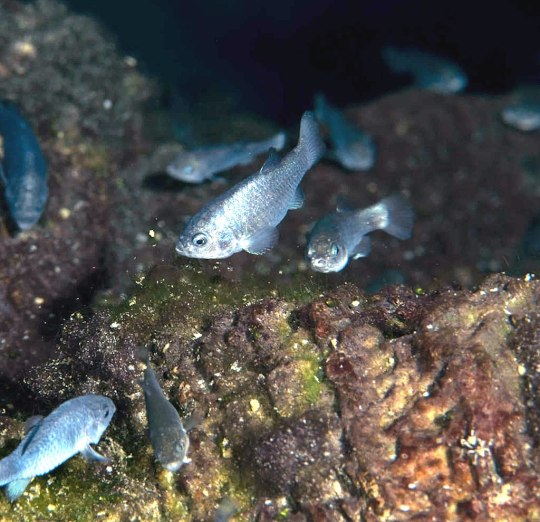
The devils hole pupfish, scientific name Cyprinodon diabolis, is an endangered fish known to live in exactly one spot, Devils hole. Devils hole is a limestone cavern with a geothermal pool found in Nye county of Nevada, and a disconnected section of Death Valley National Park. The geothermal pool keeps the water at a consistent 33 degrees Celsius all seasons, and has low dissolved oxygen amounts. The surface of water at the cave is only 72ft by 12ft, but below that the cave descends deep into the earth. Below the surface pool there is a larger cavern descending to 150 meters at its deepest before branching into a smaller tube at the bottom, the depth of which is currently unknown.1965 two teenagers went diving in the hole with scuba gear, and were never seen again, rescue divers sent after them found a dropped flashlight, and other scuba gear but the bodies were never found. One rescue diver dropped a weighted plate that fell a full 932ft without contacting a bottom to the chamber, describing the water below him as an "infinity chamber". Later scans of the cave revealed it is at least as deep as 1,247ft, although to this day the depth is still unknown. Another well known aspect of the cave is that it can be used to determine when there are earthquakes all over the world. The water surges and has displayed unique patterns during the 2022 Mexico 7.6 magnitude earthquake, along with other strong earthquakes further from the hole. Such as: the 2012 6.2 magnitude earthquake in Papua New Guinea, or the 2018 7.4 magnitude earthquake in Indonesia. Devils hole pupfish are known to live only in the first 80ft of the cave.

Devils hole pupfish are unique in appearance, getting only as large as an inch, and being one of few species that have no pelvic fins, however when raised in colder conditions these pupfish will regrow these appendages. As juveniles these fish are an off white color, and females retain some of this coloring in adulthood. This species has only ever been recorded with as many as 500 wild fish at its highest, hitting an all time low point of 42 fish in 2007. The more recent numbers are looking up however, and there were 263 pupfish observed in spring of 2022. The survival from egg to adulthood is small, but the likelihood with human effort that this fish will survive the test of time is high. Described as possibly the most isolated wild vertebrate species in the world. These fish live only 10-14 months, reaching sexual maturity at 8-10 weeks old and spawn year round with peaks in mid February-May, and a smaller peak in July-September. Due to the unique oxygen levels of devils hole, these fish have adapted to enter a state of tupor, similar to hibernation, where they can live anaerobically. This allows them to go without breathing for up to 2 hours, however they produce ethanol as a byproduct.
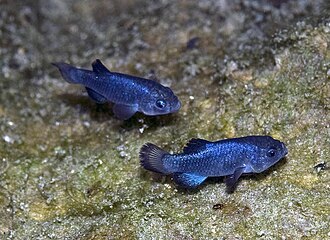
Most of the devils hole pupfish life is on the rocky outcrops of the surface waters of the cave system. Breeding, egg laying, diet, resting, and schedules surrounding the placement of the sun all depend on these rocky outcroppings of stone near the surface of the water. The diet of these fish is dependent on the rock outcroppings of the cave, as they eat anything they can find in the cave system. This includes: small freshwater crustaceans, beetles, flatworms, freshwater snails, inorganic matter made of small sections of the caves limestone, along with spirogyra and diatom algae, which grows on the rocks themselves and makes up most of the pupfish's diet. Due to their diet being mostly algae types, pupfish are incredibly susceptible to the seismic activity in the devils' hole, as it creates small tsunamis along surface water and washes away algae on the rocks, leaving them without a majority of their food source until it regrows. When these earthquakes happen the pupfish are known to flee into the deer waters of the cave until the water has stilled, and are thought to perhaps feel earthquakes before they happen, although not much research has been done on this yet.
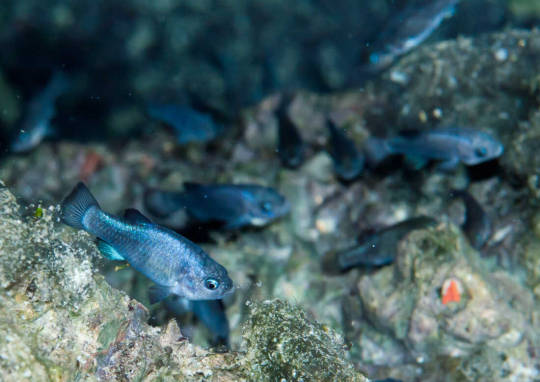
Have a good Wednesday, everyone!
#pupfish#fish#fishblr#devils hole#devils hole pupfish#nevada#Cyprinodon diabolis#death valley#death valley national park#ash medows#ash medows fish conservation
169 notes
·
View notes
Text
Spring vibration isolators - Easyflex
Easyflex spring vibration isolators are cutting-edge solutions for noise and vibration control. Engineered with precision, they effectively reduce vibrations, ensuring a quieter and more stable environment. These isolators are your go-to choice for superior performance and peace of mind.
For More Info visit : https://easyflex.in/spring-based-vibrations-isolators/

Kanwal Industrial CorporationB- 168, Phase – II, Distt. Gautam Budh Nagar -201 305 Noida, Uttar Pradesh , India
Phone: 91-0120-4734500 | +91-9811319020
#spring vibration isolators#spring vibration#Easyflex Vibration Isolation#Spring Isolators#Easyflex Products#Mechanical Engineering#Noise Reduction#Industrial Equipment#Shock Absorption#Structural Engineering#Noise Control#Anti-vibration Solutions#Machinery Isolation#Seismic Isolation#Engineering Components#Equipment Mounting#Noise and Vibration Control#Isolation Systems#Industrial Machinery#Vibration Damping#Elastic Support#Mechanical Isolation
0 notes
Text
Though on the subject of Hazbin Hotel criticism, Episode 4 happened WAY too early. It’s a great episode in isolation, but it should’ve happened near the end of the season, not at the halfway point. We haven’t spent nearly enough time with Angel and Husk for such a seismic shift in their dynamic.
But that’s just the latest in Hazbin’s God awful pacing. They’re trying to shove as much information as the can into 8-10 episodes, and it shows.
121 notes
·
View notes
Text
Pluto in Aquarius: Brace for a Business Revolution (and How to Ride the Wave)
The Aquarian Revolution
Get ready, entrepreneurs and financiers, because a seismic shift is coming. Pluto, the planet of transformation and upheaval, has just entered the progressive sign of Aquarius, marking the beginning of a 20-year period that will reshape the very fabric of business and finance. Buckle up, for this is not just a ripple – it's a tsunami of change. Imagine a future where collaboration trumps competition, sustainability dictates success, and technology liberates rather than isolates. Aquarius, the sign of innovation and humanitarianism, envisions just that. Expect to see:
Rise of social impact businesses
Profits won't be the sole motive anymore. Companies driven by ethical practices, environmental consciousness, and social good will gain traction. Aquarius is intrinsically linked to collective well-being and social justice. Under its influence, individuals will value purpose-driven ventures that address crucial societal issues. Pluto urges us to connect with our deeper selves and find meaning beyond material gains. This motivates individuals to pursue ventures that resonate with their personal values and make a difference in the world.
Examples of Social Impact Businesses
Sustainable energy companies: Focused on creating renewable energy solutions while empowering local communities.
Fair-trade businesses: Ensuring ethical practices and fair wages for producers, often in developing countries.
Social impact ventures: Addressing issues like poverty, education, and healthcare through innovative, community-driven approaches.
B corporations: Certified businesses that meet rigorous social and environmental standards, balancing profit with purpose.
Navigating the Pluto in Aquarius Landscape
Align your business with social impact: Analyze your core values and find ways to integrate them into your business model.
Invest in sustainable practices: Prioritize environmental and social responsibility throughout your operations.
Empower your employees: Foster a collaborative environment where everyone feels valued and contributes to the social impact mission.
Build strong community partnerships: Collaborate with organizations and communities that share your goals for positive change.
Embrace innovation and technology: Utilize technology to scale your impact and reach a wider audience.
Pluto in Aquarius presents a thrilling opportunity to redefine the purpose of business, moving beyond shareholder value and towards societal well-being. By aligning with the Aquarian spirit of innovation and collective action, social impact businesses can thrive in this transformative era, leaving a lasting legacy of positive change in the world.
Tech-driven disruption
AI, automation, and blockchain will revolutionize industries, from finance to healthcare. Be ready to adapt or risk getting left behind. Expect a focus on developing Artificial Intelligence with ethical considerations and a humanitarian heart, tackling issues like healthcare, climate change, and poverty alleviation. Immersive technologies will blur the lines between the physical and digital realms, transforming education, communication, and entertainment. Automation will reshape the job market, but also create opportunities for new, human-centered roles focused on creativity, innovation, and social impact.
Examples of Tech-Driven Disruption:
Decentralized social media platforms: User-owned networks fueled by blockchain technology, prioritizing privacy and community over corporate profits.
AI-powered healthcare solutions: Personalized medicine, virtual assistants for diagnostics, and AI-driven drug discovery.
VR/AR for education and training: Immersive learning experiences that transport students to different corners of the world or historical periods.
Automation with a human touch: Collaborative robots assisting in tasks while freeing up human potential for creative and leadership roles.
Navigating the Technological Tsunami:
Stay informed and adaptable: Embrace lifelong learning and upskilling to stay relevant in the evolving tech landscape.
Support ethical and sustainable tech: Choose tech products and services aligned with your values and prioritize privacy and social responsibility.
Focus on your human advantage: Cultivate creativity, critical thinking, and emotional intelligence to thrive in a world increasingly reliant on technology.
Advocate for responsible AI development: Join the conversation about ethical AI guidelines and ensure technology serves humanity's best interests.
Connect with your community: Collaborate with others to harness technology for positive change and address the potential challenges that come with rapid technological advancements.
Pluto in Aquarius represents a critical juncture in our relationship with technology. By embracing its disruptive potential and focusing on ethical development and collective benefit, we can unlock a future where technology empowers humanity and creates a more equitable and sustainable world. Remember, the choice is ours – will we be swept away by the technological tsunami or ride its wave towards a brighter future?
Decentralization and democratization
Power structures will shift, with employees demanding more autonomy and consumers seeking ownership through blockchain-based solutions. Traditional institutions, corporations, and even governments will face challenges as power shifts towards distributed networks and grassroots movements. Individuals will demand active involvement in decision-making processes, leading to increased transparency and accountability in all spheres. Property and resources will be seen as shared assets, managed sustainably and equitably within communities. This transition won't be without its bumps. We'll need to adapt existing legal frameworks, address digital divides, and foster collaboration to ensure everyone benefits from decentralization.
Examples of Decentralization and Democratization
Decentralized autonomous organizations (DAOs): Self-governing online communities managing shared resources and projects through blockchain technology.
Community-owned renewable energy initiatives: Local cooperatives generating and distributing clean energy, empowering communities and reducing reliance on centralized grids.
Participatory budgeting platforms: Citizens directly allocate local government funds, ensuring public resources are used in line with community needs.
Decentralized finance (DeFi): Peer-to-peer lending and borrowing platforms, bypassing traditional banks and offering greater financial autonomy for individuals.
Harnessing the Power of the Tide:
Embrace collaborative models: Participate in co-ops, community projects, and initiatives that empower collective ownership and decision-making.
Support ethical technology: Advocate for blockchain platforms and applications that prioritize user privacy, security, and equitable access.
Develop your tech skills: Learn about blockchain, cryptocurrencies, and other decentralized technologies to navigate the future landscape.
Engage in your community: Participate in local decision-making processes, champion sustainable solutions, and build solidarity with others.
Stay informed and adaptable: Embrace lifelong learning and critical thinking to navigate the evolving social and economic landscape.
Pluto in Aquarius presents a unique opportunity to reimagine power structures, ownership models, and how we interact with each other. By embracing decentralization and democratization, we can create a future where individuals and communities thrive, fostering a more equitable and sustainable world for all. Remember, the power lies within our collective hands – let's use it wisely to shape a brighter future built on shared ownership, collaboration, and empowered communities.
Focus on collective prosperity
Universal basic income, resource sharing, and collaborative economic models may gain momentum. Aquarius prioritizes the good of the collective, advocating for equitable distribution of resources and opportunities. Expect a rise in social safety nets, universal basic income initiatives, and policies aimed at closing the wealth gap. Environmental health is intrinsically linked to collective prosperity. We'll see a focus on sustainable practices, green economies, and resource sharing to ensure a thriving planet for generations to come. Communities will come together to address social challenges like poverty, homelessness, and healthcare disparities, recognizing that individual success is interwoven with collective well-being. Collaborative consumption, resource sharing, and community-owned assets will gain traction, challenging traditional notions of ownership and fostering a sense of shared abundance.
Examples of Collective Prosperity in Action
Community-owned renewable energy projects: Sharing the benefits of clean energy production within communities, democratizing access and fostering environmental sustainability.
Cooperatives and worker-owned businesses: Sharing profits and decision-making within companies, leading to greater employee satisfaction and productivity.
Universal basic income initiatives: Providing individuals with a basic safety net, enabling them to pursue their passions and contribute to society in meaningful ways.
Resource sharing platforms: Platforms like carsharing or tool libraries minimizing individual ownership and maximizing resource utilization, fostering a sense of interconnectedness.
Navigating the Shift
Support social impact businesses: Choose businesses that prioritize ethical practices, environmental sustainability, and positive social impact.
Contribute to your community: Volunteer your time, skills, and resources to address local challenges and empower others.
Embrace collaboration: Seek opportunities to work together with others to create solutions for shared problems.
Redefine your own path to prosperity: Focus on activities that bring you personal fulfillment and contribute to the collective good.
Advocate for systemic change: Support policies and initiatives that promote social justice, environmental protection, and equitable distribution of resources.
Pluto in Aquarius offers a unique opportunity to reshape our definition of prosperity and build a future where everyone thrives. By embracing collective well-being, collaboration, and sustainable practices, we can create a world where abundance flows freely, enriching not just individuals, but the entire fabric of society. Remember, true prosperity lies not in what we hoard, but in what we share, and by working together, we can cultivate a future where everyone has the opportunity to flourish.
#pluto in aquarius#pluto enters aquarius#astrology updates#astrology community#astrology facts#astro notes#astrology#astro girlies#astro posts#astrology observations#astropost#astronomy#astro observations#astro community#business astrology#business horoscopes
109 notes
·
View notes
Text
Titan History: Kong
Welcome once again to Monarch: After Dark, the digital gateway between you and the organisation dedicated to understanding and navigating this troubled new world we live in.
Apologies for the lack of communication in recent weeks, Monarch has been hard at work collecting data and collaborating with global governments through the most recent Titan crisis, including the disposal of deceased Titan remains and the best course of action to take with Godzilla in his new resting place.
That said, today's communication will be going over a Titan who has been surging in popularity across the globe over the past few years; the undisputed king of the Hollow Earth, Kong.
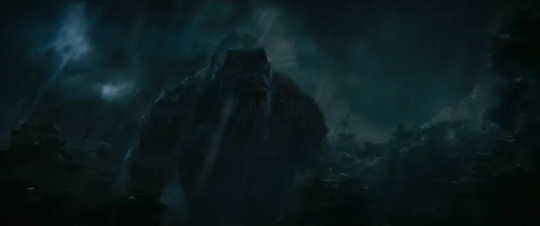
(Pictured above: Kong approaching an Apex Cybernetics research facility on Skull Island, circa. 2017)
Monarch Database File: Kong
Monarch Designation: Titanus Kong
Height: 337 feet
Weight: Unknown
Nature: Unknown
Behavioural Classification: Protector
-----
Until recently, Kong was believed to be the last of his kind. Born during a climactic final battle between his parents and a horde of Skullcrawlers (ravenous amphibian predators on Skull Island), Kong grew up in an isolated world filled with danger at every angle. Growing up to become the guardian deity of Skull Island, Kong was held in great reverence by the native Iwi tribe that lived on the island. His species, designated Apus giganticus, were also known protectors of the Iwi, fighting off the Skullcrawlers and other threats until their last breath.
During his centuries on the island, Kong fought a variety of creatures, from the Mire Squad and Sirenjaws to other Titans such as the mysterious Kraken or night-bringer Camazotz. However, in 2021, a storm generated by Monster Zero fused with the perpetual storm surrounding Skull Island and plunged it into chaos. Three years later, in 2024, Kong was removed from the island as the key to a daring plan to uncover a Hollow Earth energy source to stop Godzilla. The two alpha Titans clashed twice before setting aside their differences to take down Apex Cybernetics' rogue superweapon, Mechagodzilla.
Currently, Kong now resides in the Hollow Earth alongside a newly-freed tribe of his speices, an orange ape-like Titan which he seems to have adopted as a son, and the ancient ice Titan Shimo.

(Pictured above: Monarch officials reviewing recovered footage of Kong from the doomed 1973 expedition to Skull Island, circa. 2019)
While Kong's exact origins are unknown, research conducted within the Iwi settlement appears to place his birth somewhere in the 17th Century, making him perhaps the youngest Titan on record. However, his entangled history with Monarch began much later, in 1973.
In a time where Monarch was on its last legs and facing the possibility of being shut down, founding figure William Randa and geological advisor Houston Brooks lobbied to piggyback on a Landsat expedition to Skull Island. With a military escort courtesy of the Sky Devils squadron, the team dropped seismic charges on the island to map the bedrock beneath the surface. Unknown to them at the time, their charges awakened the Skullcrawlers living in thermal vents beneath the island and incurred Kong's wrath.
Kong swiftly destroyed the Sky Devils' helicopters, leaving the survivors split into two groups. One, including Brooks, encountered the Iwi and stranded WW2 pilot Hank Marlow, where they learned about Kong and his history with the Skullcrawlers. A second, including Randa, embarked on a mission of revenge driven by Colonel Preston Packard.

(Pictured above: Kong battling the remnants of the Sky Devil squadron after being lured into a napalm trap, circa. 1973)
After being lured into a napalm trap by Packard, Kong was initially helpless to battle the recently awakened Skull Devil, the last of the adult Skullcrawlers that had a hand in wiping out his family centuries prior. Recovering quickly, the two beasts engaged in a brutal encounter. Following some assistance from the expedition survivors, Kong triumphed by tearing out the Skull Devil's innards, avenging his parents in the process.
His next major sighting occured in 1993, but without a Monarch presence on Skull Island at the time, this is pending investigation. According to witnesses, Kong did battle with a large underwater Titan (designated 'Kraken'), after being coaxed to the island's coast by Annie, a young girl stranded on the island for years with a strange dog-like beast as a companion. After exchanging many blows, Kong ultimately killed the Titan by tearing its body in half.
In 1995, Aaron Brooks (Houston's son) led an unauthorized expedition to Skull Island, as he felt unsatisfied with leaving protection against the Skullcrawlers to Kong alone. During their stay, mythographer Walter Riccio experienced vivid visions of Kong's origins, under the influence of an Iwi medicinal drink. When Riccio destroyed the wall to the Iwi village, Kong stepped in to vanquish the Mother Longlegs swarm that seized their chance and killed Riccio before communing with Aaron and the Iwi.

(Pictured above: Artistic rendition of Kong tearing the "Kraken" Titan in two, based off eyewitness testimony, circa. 1993)
In the following decades, Kong was largely left to his own devices as the island's guardian. Though Monarch teams briefly assisted him in 2015 with a crisis involving the unknown organisation Janos Biotech and the island's Snarehunter population, and Kong himself kept a horde of Skullcrawlers that attempted to leave the island in response to Monster Zero's 'alpha call' in 2019, no major events really transpired between 1995 and 2021.
In 2021, as mentioned previously, Skull Island was plunged into chaos when one of Monster Zero's residual storms merged with the storm system surrounding Skull Island. When darkness fell, the bat Titan Camazotz emerged and battled Kong for dominion over the island. Thanks to a daring pilot triggering a sonic boom to disorient Camazotz, Kong was able to prevail, though he was ultimately unable to save his home.
Three years later, and the artificial habitat Monarch built for Kong was unable to hold him much longer. He was reluctantly taken to the sea and transported to Antarctica's Outpost 32 (now rebuilt as a Hollow Earth station), though not without attracting Godzilla, who destroyed the naval fleet transporting him and almost drowned the ape. Following the acquisition of an axe left in the Hollow Earth by his ancestors, Kong and Godzilla clashed again in Hong Kong. While Godzilla prevailed through sheer power, Kong refused to submit to his rule.
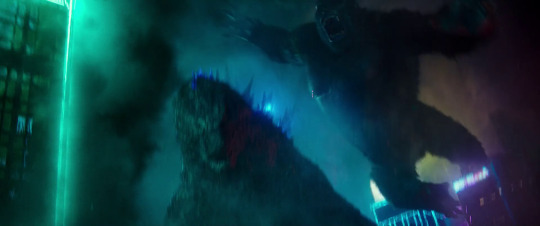
(Pictured above: Kong leaping onto Godzilla's back from a building after staging an ambush, circa. 2024)
After being revived by an exploding H.E.A.V, Kong jumped in to stop Mechagodzilla from executing his organic counterpart. Setting aside their differences, the two Titans teamed up to take down the mecha. A blast from Godzilla's atomic breath charged up Kong's axe, and he was able to deal the finishing blow by hacking Mechagodzilla to pieces and holding its severed head in triumph. The two Titans regarded each other one more time before parting ways.
Which brings us to the present. While much of what transpired is still being compiled to our databanks, it is known that Kong returned to the surface on three different occassions. The first was to have an infected tooth removed at a Monarch facility, the second was in Egypt to coerce Godzilla into assisting him, and the third was a two-on-two battle in Brazil between Kong and Godzilla, and Shimo and the "Skar King", evil ruler of the Kong tribe in Hollow Earth.
-----
And there you go! An up-to-date account of Kong's history in the modern world, intertwined with Monarch from the 1970's. Currently, Kong is enjoying life down in the Hollow Earth, and as the world should do, this is where we leave Kong's story be, until the world needs him again.
Until next time,
Monarch: After Dark
#monarch#monarch after dark#monsterverse#king kong#godzilla#kong skull island#skull island#godzilla vs kong#godzilla x kong the new empire#skullcrawlers#kong
21 notes
·
View notes
Text
Rewatching one of my favorite childhood movies, Tremors, a b horror movie starring Kevin Bacon and Fred Ward about underground monsters that hunt by sound, and I want to talk about a specific character.

Specifically the main female lead and love interest to Kevin Bacon’s Valentine- Rhonda Lebeck. For a movie made in 1990, Rhonda is a surprisingly feminist portrayal of a female lead (like Laura Dern’s Ellie in Jurassic Park).
Rhonda is a student studying seismic activity in the isolated town of Perfection, Nevada and is constantly acknowledged, by every character int he movie including (and especially) the men, as the smartest person in town. They constantly ask her opinion and respect her intelligence and never question the fact that a woman is smarter than they are. Any time she has an idea it is never question because she is a woman and she never has to do that not-really-feminist-a-woman-must-prove-herself thing movies to this day still do.
There is one scene about halfway through the movie where Rhonda gets tangled up in barbed wire and must take off her pants in order to escape the monster dragging her into it’s mouth using said barbed wire. The scene is in no way played as sexual, or a gratification scene for the men watching the movie. any close up of Rhonda is shot from the waist up and we only see her bare legs in wider shots meant to showcase the monster, not her half-nakedness. the only time we see a closeup of her bare legs is when her wounds are being tended to, it only lasts a few moments, and you can see that she has hair on her legs. Which took me a few re-watches to notice but I feel added to the non-sexual take on her bare legs, as even to this day women in movies and tv are always shaved as smooth as dolphins.

She also dresses appropriately for the situation she’s in- hiking boots, cargo pants, long sleeved shirt. Earlier in the movie she wears shorts that aren’t halfway up her ass. She dresses for doing fieldwork in the middle of the desert and the filmmakers didn’t take it as an opportunity to have her parading around in short shorts and a bikini top like some movies have done to female characters in horror movies.
I just like how Rhonda is treated like a character, not just a two dimensional love interest. The relationship between her and Valentine is also really sweet and it’s revealed in later movies, that neither character appear in, that they get married and have a daughter together (although it is implied in later movies the two have gotten divorced).
Just a solid character and one of my favorite female characters in a movie.
108 notes
·
View notes
Note
The more I see you engage with atla live action stuff the more I hope you're also taking plenty of time to focus on things you like - take care of yourself, ok?
Anyway here's a thought that occurred to me: I think Jeong Jeong would get along startlingly well with some of the foggy swamp benders.
1. 💕 that is so sweet of you anon. to be fully honest i am unemployed right now so i definitely need to be aware of how i'm spending my time. to some degree complaining about a show is a welcome distraction but i definitely need to keep an eye on it and this is a useful reminder.
2. at first i was like huh? and then i remembered huu, the guy who sat with them and told them how the swamp was all interconnected and how that was a metaphor for the world and its web of connections. that is someone jeong jeong could get along with. jeong jeong is living in the woods to isolate himself but the swampbenders' relationship to their environment is one of connection. he has some sense of that connection, some idea that he has a place in the interconnected web of things (his line about the sun being greatest source of fire and being in balance with nature) but he also very much feels that firebending has no place in the world. the swampbender teachings could be helpful for him. also, he likes waterbenders, so the swampbenders are definitely up his alley in that way.
the swamp is also the place toph goes in lok to isolate herself while also staying sort of connected to the world via the vines, and i've always thought he and toph would get along. they're both strongly individual, rebelling against their repressive societies to become their own people following their own beliefs. toph's approach of waiting and listening is a quintessential earthbender quality he clearly admires - his bending style is very earth, with strong walls and sturdy stances. not that a twelve-year-old would fix an old man, but i also think her groundedness would help get him out of his own head. she'd listen to him go off about bending and how fire is destructive and then say a very simple but wise thing about the usefulness of fire and how useless it is to wallow and complain. and it'd be so reasonable that jeong jeong would have to pause. toph also has such a close relationship to her bending because it's a disability aid, so she'd have insight into how bending isn't just fighting, it's a part of who you are and how you interact with the world. maybe firebenders can do a heat-sensing thing that's similar to seismic sense, and with her help jeong jeong learns to use it.
so yeah, i think you're right about the swampbenders and jeong jeong. you wouldn't expect it, but there is some overlap and some wisdom there.
14 notes
·
View notes